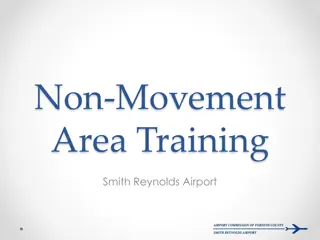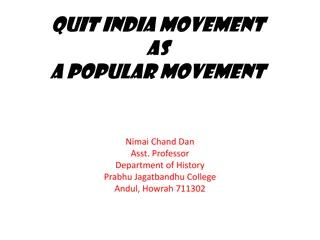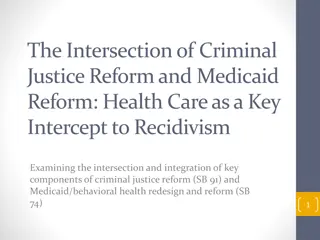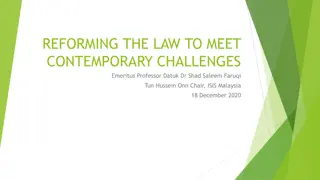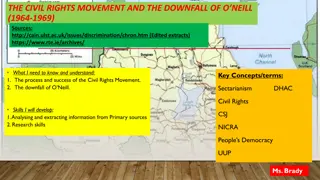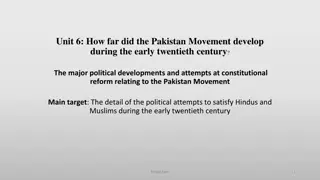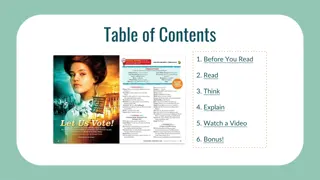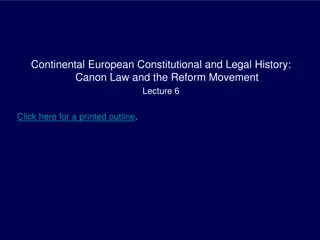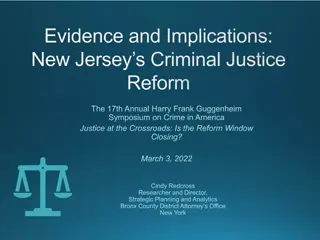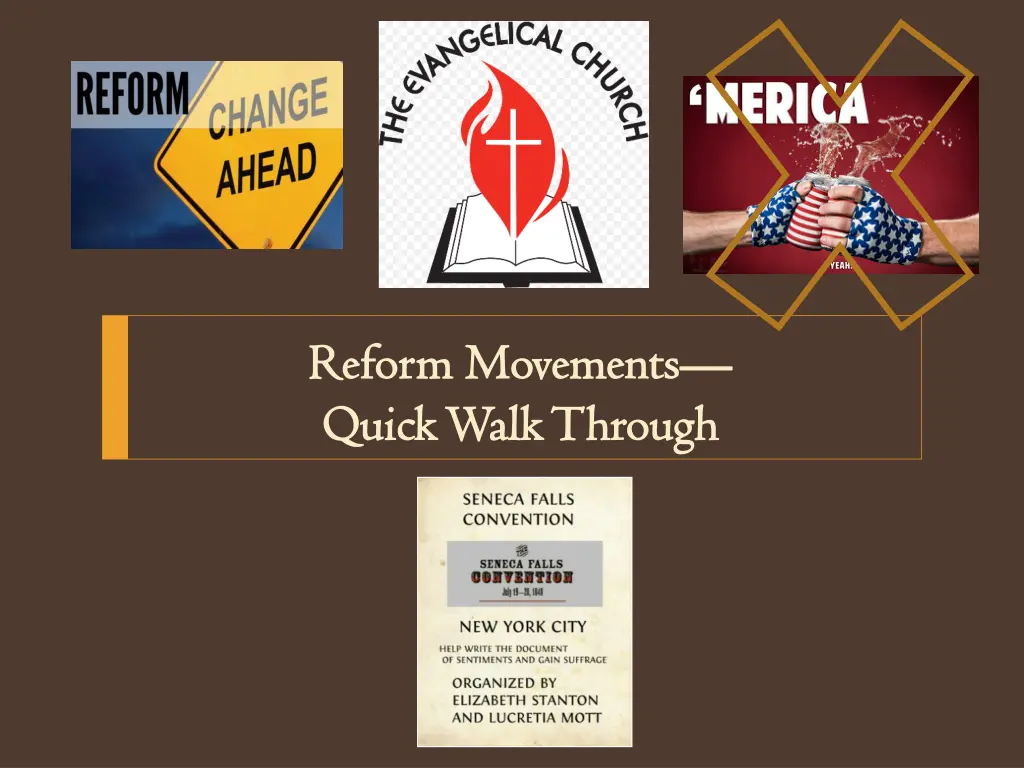
Emergence of Reform Movements in U.S. History
Explore the emergence of reform movements in U.S. history, driven by factors like urban problems, industrialization, and evangelical fervor. Examples include temperance and abolitionism, highlighting the challenges and successes of these movements.
Download Presentation

Please find below an Image/Link to download the presentation.
The content on the website is provided AS IS for your information and personal use only. It may not be sold, licensed, or shared on other websites without obtaining consent from the author. If you encounter any issues during the download, it is possible that the publisher has removed the file from their server.
You are allowed to download the files provided on this website for personal or commercial use, subject to the condition that they are used lawfully. All files are the property of their respective owners.
The content on the website is provided AS IS for your information and personal use only. It may not be sold, licensed, or shared on other websites without obtaining consent from the author.
E N D
Presentation Transcript
Reform Movements Reform Movements Quick Walk Through Quick Walk Through
Reform Movements in U.S. History Reform Movements in U.S. History Reform: to make changes to a social, political, or economic institution or practice in an effort to improve it In U.S. history, reform usually happens slowly; examples: Electoral laws Abolition An exception? gay rights In P4-5, we have many reform movements in the North, generally with little success nationally: education, temperance, asylum, women s rights, etc.
Why do Reform Movements Emerge in P4? Why do Reform Movements Emerge in P4? Reason 1: Northern industrialization throughout the 1800s led to urban problems that were increasingly apparent to the middle class Traditional charities weren t adequate to deal with the vulnerable New York City
Why do Reform Movements Emerge in P4? Why do Reform Movements Emerge in P4? Reason 2: Evangelical fervor increased due to the Second Great Awakening (1790s-1830s), which was similar to the First (1720s- 40s) but focused more on the individual s duty to society Northern religious reformers often women became obsessed with perfecting themselves + their communities reform efforts
Example: Temperance Example: Temperance Excessive drinking led to violence, crime, domestic abuse, economic problems Reformers mostly evangelical women tried to prohibit drinking, beginning in the 1820s Criticism: were quite nativist (antiimmigrant) in their rhetoric Had some success drinking decreased by mid-1840s, but did economic calamity (Jackson) cause that? Generally men didn t appreciate the role of women in this movement + immigrants who drank more on average than native born Americans were hostile to temperance reform National prohibition = 1920; repealed in 1933
Example: Abolitionism Example: Abolitionism Reformers mostly evangelical men and women helped slaves escape, flooded the nation with its literature (i.e. William Lloyd Garrison) Only got about 10% support due to widespread opposition: Southerners were outraged (obviously) + tried to suppress abolitionist speech of any kind Northerners often objected because they were largely antiblack + feared miscegenation (etc.) Abolition wouldn t come until the end of the Civil War, with the 13th Amendment (1865), but sharecropping took its place
Example: Womens Rights Movement Example: Women s Rights Movement Women wanted to go from Republican Mothers devoid of rights to active participants in the republic Became involved in the reforms and church In 1848, 300 women and men attended the Seneca Falls Convention Wrote the Declaration of Sentiments, modeled after the Declaration of Independence (1776) Detailed the oppressions men had imposed on women, just as Jefferson had done for the king Reasserted republican principles but with a twist men AND women have unalienable rights that governments must protect
Example: Womens Rights Movement Example: Women s Rights Movement Criticism: expressed nativist sentiment (lousy immigrants can vote and women can t?!) Only 100 of the 300 signed because passages on elective franchise were seen as too radical Women wouldn t receive the vote until 1920
Excerpt from Seneca Falls (1848) Excerpt from Seneca Falls (1848) The history of mankind is a history of repeated injuries and usurpations on the The history of mankind is a history of repeated injuries and usurpations on the part of man toward woman, having in direct object the establishment of an part of man toward woman, having in direct object the establishment of an absolute tyranny over her. To prove this, let facts be submitted to a candid absolute tyranny over her. To prove this, let facts be submitted to a candid world. world. He has never permitted her to exercise her inalienable right to the elective franchise. He has compelled her to submit to laws, in the formation of which she had no voice. He has made her, if married, in the eye of the law, civilly dead. He has taken from her all right in property, even to the wages she earns After depriving her of all rights as a married woman, if single and the owner of property, he has taxed her to support a government which recognizes her only when her property can be made profitable to it. He has monopolized nearly all the profitable employments . . . . He closes against her all the avenues to wealth and distinction . . . . He has endeavored, in every way that he could, to destroy her confidence in her own powers, to lessen her self-respect, and to make her willing to lead a dependent and abject life.




